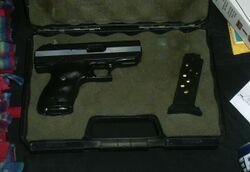Engineering:Hi-Point C-9
| Hi-Point C-9 | |
|---|---|
 C-9 Pistol | |
| Type | Semi-automatic pistol |
| Place of origin | United States |
| Production history | |
| Designer | Tom Deeb |
| Manufacturer | Hi-Point Firearms |
| Specifications | |
| Mass | unloaded 25oz (709 g); 29oz (822 g) loaded per spec |
| Length | 6.75 in (171 mm) |
| Barrel length | 3.5 in (89 mm) |
| Cartridge | 9×19mm Parabellum |
| Action | Blowback |
| Muzzle velocity | 1,279.5 ft/s (390 m/s) |
| Feed system | 8-round, 10-round, or 15-round[1] detachable box magazine |
| Sights | blade front, notch rear (adjustable) |
The Hi-Point Model C-9 is a polymer-framed, semi-automatic, blowback-operated pistol manufactured by Hi-Point Firearms. It is chambered in 9×19mm Parabellum and is rated to accept +P ammunition. It gained notoriety with its low retail price of under $200.
Model C-9
The Model C-9 is a compact, single-stack magazine, model of Hi-Point's 9×19mm handgun. It consists of a polymer frame, zinc-alloy slide and bolt (with steel reinforcing inserts), and a steel breech, chamber and barrel. Its low price and small and compact design prompted many to purchase it for concealed carry.[citation needed] Some decline to carry the C9 in Condition One ("cocked and locked" - generally considered to be the preferable condition for defensive carry) because of the striker fired design which lacks a firing pin block.[citation needed]
Hi-point's handguns use a blowback design similar to that used in the Walther PPK and Russian Makarov PM. In blowback weapons the mass of the slide and bolt absorbs the rearward force generated by the propulsion of the bullet. As the pressure drops to a safe level, the slide moves back, (along with the bolt), an extractor hooks the empty casing and pulls it out of the chamber, after which the case is ejected from the weapon by the ejector. When the slide has completed its rearward travel, the recoil spring moves the slide forward, chambering another round. Many, if not most, modern handguns use a locked-breech design and therefore do not require the amount of slide mass that the blowback design requires in order to remain comfortable to shoot, safe to fire, and easy to control during the firing process.
Model C-9 Comp.
The C-9 Comp (short for "Compensated") is the larger version of Hi-Points 9 mm handgun. Its major difference from the C-9 Compact is that it has a specially designed "compensator" attached to the end of the barrel. The compensator works by forcing some of the hot gases, escaping behind the bullet, to go upward through specially drilled holes in the top of the compensator. The escaping gases push the end of the gun downward; helping to eliminate some of the upward motion caused by the natural recoil of the gun. The underside of the Compensator has been machined with rails to accept the addition of accessories such as a flashlight or laser sights for better target identification.
Another difference between the C-9 and C-9 Comp. is the barrel length. Its 4" barrel is 1/2" longer than its sister weapon's providing for better accuracy and balance. The compensator and extra bulk also increase the weight. Weighing in at 35 oz., it is fully 6 oz. heavier than the new model, and 2 oz. heavier than the older model of the C-9 Compact.
Criticisms
Though the C-9, C-9 Compensated, and other Hi-Point handguns have been criticized for their weight,[2] the empty or unloaded weight of the C-9 has been trimmed from 29 ounces (822 g) to 25 ounces (709 g) by using a polymer frame, making its weight comparable to other pistols with similar magazine capacities.
Some consider the lack of a firing pin block safety mechanism in the striker fired design to be inherently less safe than other designs and, therefore, not safe to carry Condition One.[3] This belief is debatable, given that the popular and long-lived Colt 1911 is often carried 'cocked-and-locked', with only the thumb safety engaged.[4]
While some after market magazines may not work well with the C-9, these may be traced to out-of-spec magazine feed ears.[5] A simple adjustment of the ears can often solve the problem. Other feed issues are often solved by polishing the feed ramp, switching to another brand of ammunition, or simply honoring the industry standard "break in period" to give both the firearm and magazines a chance to properly break in and mate moving parts. The suggested break in period for Hi-Point pistols is between 100 and 200 rounds. If this does not solve the problem, customer support for Hi-Point will send a replacement firing pin and springs, along with a new replacement magazine, which will solve some of the "feed" problems free of charge.[citation needed]
See also
- Hi-Point Firearms
- Hi-Point CF-380
- Hi-Point Model 40SW
- Hi-Point .45 ACP
- Hi-Point Carbine
References
- ↑ 1.5, Prestashop. "HIP-A3 - Hi-Point 995 / 995TS 9mm (15)Rd Blue Steel Magazine - ProMag Industries". https://promagindustries.com/hi-point/165-hi-point-995-995ts-9mm-15rd-blue-steel-magazine-.html.
- ↑ "Hi Point C9 9mm - A Good, Cheap Gun - GunsAmerica Digest". 19 February 2012. http://www.gunsamerica.com/blog/hi-point-c9-9mm-a-good-cheap-gun/.
- ↑ "Hipoint Firearms Forums". http://www.hipointfirearmsforums.com/Forum/index.php/topic,38285.msg477743.html#msg477743.
- ↑ http://smartcarry.com/mainwebsite_html/cocklock.htm Smart Carry.com article, Cocked and Locked
- ↑ "Hipoint Firearms Forums". http://www.hipointfirearmsforums.com/Forum/index.php/topic,26214.0.html.

